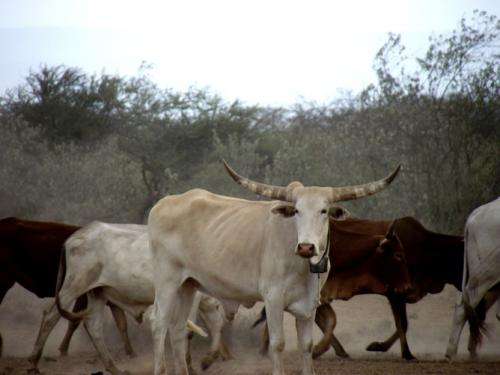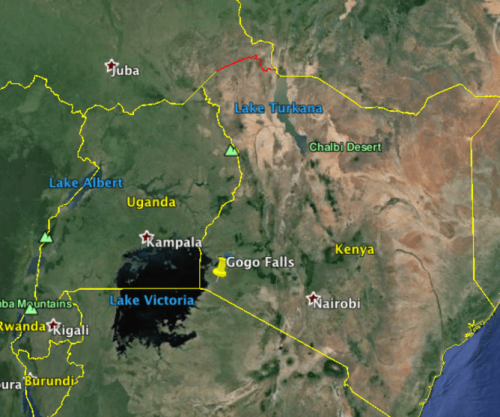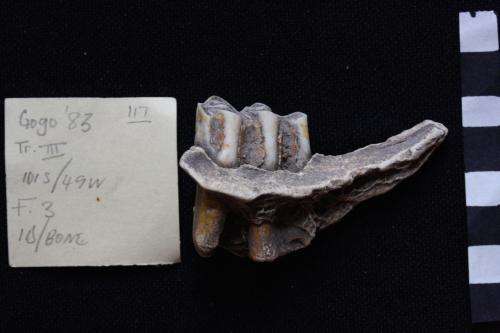Tooth enamel provides clues on tsetse flies and the spread of herding in ancient Africa

One of the most important technological advances of our species happened for the first time only in the last 12,000 years: food production, including agriculture and animal husbandry. For nearly 7 million years prior, our ancestors relied on hunting, scavenging and fishing for food. Food production made our species hugely successful and largely changed the structure of society. It's what allowed our population to increase to today's more than seven billion people.
The origin and spread of food production is different on each continent. In Africa, livestock domestication preceded plant domestication. The first food producers there lived in the north sometime between 10,000-8,000 years ago and slowly spread southward across the continent. Herders had made their way into eastern Africa in what is now modern Kenya by around 4,500 years ago. They slowly spread southward through Kenya and into northern Tanzania over the next 1,500 years. Then, there's a gap in the record, until domestic sheep and goats appeared in South Africa about 2,000 years ago.
The disconnect between these two archaeological records is puzzling, as is the lack of sites between the two regions. What happened in the missing millennium and how did livestock domestication make it all the way to the southern tip of Africa? Our new analysis using dental enamel from animals that died thousands of years ago is shedding new light on this question – and changing some common assumptions about early herders.
If you can herd, you do?
One hypothesis is that deteriorating climate and less favorable rainfall over the last 10,000 years pushed herding technology across Africa. People domesticated their own flocks as they were no longer able to rely for food on natural resources, such as wild animals and fish. But one archaeological site bucked this trend: Gogo Falls in southwest Kenya, close to Lake Victoria. The site was occupied by people between 1,900 and 1,600 years ago who, rather than relying almost entirely on livestock, also hunted and fished for nearly half of their resources. We know this by comparing the number of domestic versus wild animal remains found during site excavation.
The assumption was that the people at Gogo Falls must have lived in a place that just wasn't good for keeping animals. The major deterrent of livestock maintenance in Africa is the presence of the tsetse fly. These insects carry the often fatal disease sleeping sickness, which affects both livestock and people. Tsetse flies only live in bushy, wet environments. The idea is that the Gogo Falls residents likely didn't rely completely livestock because their environment – namely a bushy, wet one with lots of tsetse flies – made it too difficult. It also seemed to support the gap in the archaeological record between eastern and southern African herders: the tsetse flies would have created a natural barrier across the continent.

Investigating via proxy
Scientists use many methods to figure out environments of the past. We have to look at indirect measures, called proxies, because we don't have any direct forms of evidence. Our team used a technique called stable isotope analysis which examines different kinds of elements preserved in biological tissues as an indicator of diet.
The old adage "you are what you eat" is actually true. All of the plants and animals we consume are made of carbon. There are different kinds of carbon: heavy carbon-13 and lighter carbon-12. In Africa, grasses have more carbon-13, and woody plants, such as trees and bushes, have more carbon-12. When we measure carbon in an animal's tissues, we can tell what it has been eating. We analyzed tooth enamel because it's easy to identify an animal based on its teeth. The ancient teeth were selected from collections at the National Museums of Kenya in Nairobi, Kenya.
To sample the enamel, we use an instrument similar to a dental drill. We put the drilled enamel powders in acid, which converts the enamel carbon to carbon dioxide. The gas is then analyzed by an instrument called an isotope ratio mass spectrometer. The heavy and light carbon dioxide are separated by a strong magnet, then sent to a detector which measures the amounts of both heavy and light carbon. This gives us the C-13/C-12 ratio.
When we analyzed the carbon isotopes in teeth from animals excavated at the site – both domestic (cows, goats and sheep) and wild (African antelopes, warthogs, hippos, zebras) – we found that at least 10 out of 13 species of animals had more than 80% grass in their diet. So at the time, this environment was abundantly grassy, with little evidence for bushland.

We wanted to be sure of our results, so tracked down another environmental proxy; a previous study examined carbon isotopes from preserved leaves in lakebed mud that date to the same time period. That data also implied that about 80% of the plant material that ended up in the lake came from grass. This gave us confidence that the environment at Gogo Falls reflected the greater ecology around the lake, and that there were probably very few tsetse flies there at that time.
More than one way to make a living as a herder
Until now, the common assumption was that once a population started herding, they would embrace that mode of food production completely – most likely for environmental reasons as it became harder and harder to find enough food in the wild. But the ancient Gogo Falls residents herded just a bit on the side of all their other foraging and hunting. Our findings suggest that it wasn't the environment that restricted them from herding. They made a conscious decision to not rely entirely on livestock for food. They might have done this for social, political or cultural reasons.
Additionally, the evidence from our paper suggests that there wasn't a tsetse fly barrier near Lake Victoria that prevented people from moving to South Africa.
These data change a lot of our thinking in how the first herders in Africa made a living. Social factors, rather than simply responding to local environment, must play a significant role in deciding how and when to hunt or herd. There is much more diversity in these mechanisms than we previously thought.
Source: The Conversation
This story is published courtesy of The Conversation (under Creative Commons-Attribution/No derivatives).
![]()



















